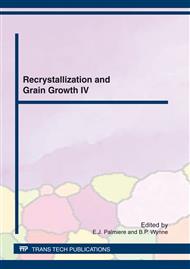p.543
p.549
p.550
p.551
p.557
p.563
p.568
p.574
p.579
Assessment of the Stored Energy Evolution during Batch Annealing Process of Cold Rolled HSLA Steels
Abstract:
Stored energy in deformed metals plays an important role during the annealing process by providing the initial driving force for recovery and recrystallization. Many direct or indirect measurement and calculation methods have been used to evaluate the amount and distribution of the stored energy in the past decades. The advent of relatively new analytical techniques such as Electron Back-Scattered Diffraction (EBSD) has permitted the development of mathematical models such as Sub-grain Method, Image Quality (IQ) Method and Taylor Factor Method etc., these new techniques have permitted a much better understanding of the annealing behavior of cold rolled steels. The sub-grain method based on the level of sub-grain structure is used in our study to quantify the stored energy distribution prior to and its evolution during the batch annealing process of cold rolled HSLA steels. Orientation dependent stored energy distribution maps at different annealing stages have been constructed and analyzed. The results of this study show that the stored energy increases with cold rolling reduction ratio and its distribution through the thickness of the steel sample is not uniform due to the inherit inhomogeneous deformation process. The stored energy was continuously consumed during annealing. The amount of γ-fiber was relatively lower than the α-fiber in the specific steel sample, which can have a strong effect on the available driving force for recovery and recrystallization. Hence other structural factors such as precipitation and/or solute drag might become more important in controlling the kinetic behavior of the steel during annealing.
Info:
Periodical:
Pages:
557-562
Citation:
Online since:
April 2012
Authors:
Keywords:
Price:
Сopyright:
© 2012 Trans Tech Publications Ltd. All Rights Reserved
Share:
Citation:


